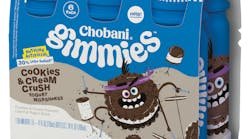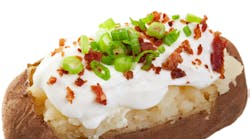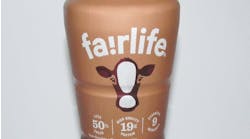Not long ago, North Americans viewed yogurt as some exotic European health food. Then two French dairy companies, Danone and Sodiaal (with its brand Yoplait), landed on these shores and changed American minds. And sales began to soar.
With General Mills licensing the Yoplait franchise and Danone anglicizing its name to Dannon, a uniquely Americanized version (some would say that unflatteringly) of the cultured dairy product evolved. Products debuted in Trix flavors and in squeezable tubes. Dannon was sued for overstating Activia health claims.
Health fanatics began discounting yogurt as cultured, candyfied milk. Sales began to suffer.
As with all successful products, niches began to appear. A Greek company, Fage, began importing an eastern European version of yogurt, strained as it had been traditionally. The result had more protein but less sugar and even a slightly bitter taste, and the original lineup had none of the tutti-frutti flavors rampant at the time … which pleased the health fanatics and also won over parents who wanted their kids to have more protein and less sugar.
But this alternative category didn't take off until a Turkish immigrant bought a shuttered Kraft yogurt plant in upstate New York and started making yogurt like he had back home. Suspecting that a Turkish label wouldn't catch on, he called his version Greek-style yogurt, because it resembled that being made by Fage.
"Chobani" means shepherd in Turkish and other Mediterranean languages, and Hamdi Ulukaya's company went from zero in 2007 to a billion dollars in sales in about six years (in the process becoming our Processor of the Year in 2012). And after Danone and General Mills jumped in, Chobani plateaued for a bit but the Greek yogurt category continued to soar.
Chobani, which rocketed on the strength of regular Greek yogurt, has nonetheless branched out, marketing its product as a cooking ingredient and pursuing children's tastes.
The overall yogurt market in the U.S. grew a modest 1.18% annually 2013-2018 with a sales value of just under $8 billion, reports Global Data. The category's strongest performance was in 2014, when it grew by 4.23% over the previous year, with most of that fueled by the peaking popularity of Greek yogurt. But even Greek yogurt's novelty wore off and overall yogurt sales in 2017 fell by -1.52% over 2016.
Overall yogurt sales in North America have since rebounded and are predicted to grow about 3% a year now through 2024, according to a report by Transparency Market Research. Danone, Chobani and General Mills control an estimated 75% of the market, but novel products keep popping up.
At March's Natural Products Expo West, for instance, there were yogurts made from every imaginable mammal (especially goats, sheep and camels) as well an increasing array of non-dairy/plant-based ones. Plus, new Australian, Icelandic and other geographic-based styles of yogurt are competing with Greek's supremacy.
Greek yogurt is bouncing back as well. The global Greek yogurt market was worth $7.4 billion in 2018, according to IMARC Group, which expects the market to reach a value of $12.3 billion by 2024, exhibiting a compound annual growth rate of around 9% from 2019-2024.
One of the reasons for the Greek revival is the use of product for more than breakfast snacking. Greek yogurt increasingly is being used in meal preparation and as a substitute for sour cream, smoothies, cream cheese and butter.
Problematic whey
One of the challenges faced in dairy comes about when a product explodes in popularity, leaving a byproduct that is hard to know what to do with. That happened with Greek yogurt and acid whey.
In general, whey is an example of a byproduct that went from disposable to valuable enough for cheese and yogurt processors to recover.
“Previously, the curd was concentrated using a centrifuge or through compression, and the whey produced simply drained away as waste,” says Pranav Shah, process category director for fresh dairy at SPX Flow Inc., a supplier of pumps and other processing equipment.
“This is no longer the case, and processing lines are designed to reuse the whey to make products such as drinkable yogurts, through the addition of solids to the whey," he continues. "Modern processing lines, therefore, produce high protein yogurt on one side and, on the other side, appealing, drinkable yogurt. This increases revenue from the milk and removes the waste.”
Greek yogurt, however, poses a problem in this regard. It came out of nowhere to dominate the category, going from about 1% of the market in 2001 to roughly half by 2016. The whey that it leaves behind is problematic because it has about 10 times more lactic acid than regular sweet whey. This severely restricts its potential as a food ingredient.
The sour taste due to the low pH can be mitigated with sweeteners, but the whey’s lactic acid content prevents spray-drying on most commercial equipment, because it will stick to the dryer’s walls instead of forming a powder. This makes it virtually impossible to use as whey protein concentrate, which has become a key ingredient in products like baby formula and protein shakes.
Acid whey is tough to throw away, too. Most municipalities won’t accept untreated whey in sewage because its high protein content would increase the sewage’s biochemical oxygen demand (a measure of how liable it is to nourish undesirable microflora in waterways). That leaves two expensive alternatives for disposal: onsite pretreatment or shipment offsite for landfilling or use as fertilizer.
General Mills has managed to mitigate the cost of pretreating the acid whey from the Greek yogurt made at its plant in Murfreesboro, Tenn. The anaerobic digester that treats the plant’s whey and other effluent generates methane, which is used to power a generator that provides 1.6 megawatts of electricity. This is about 10 percent of the plant’s overall power needs, for a utility savings of $2.4 million a year.
Milk almost always has to be pasteurized to meet U.S. federal regulations. But some nonthermal treatments can extend the shelf life of either fluid milk or products made from it.
Microfiltration and nanofiltration are used in conjunction with pasteurization for additional shelf life, says Nancy Huls, vice president of research and innovation of Midwest Dairy, a research and advocacy group.
“Bacteria and spores can be removed from the product and could be used to increase shelf life of the milk as it filters out spoilage organisms that HTST [high temperature/short time] pasteurization may not,” Huls says. “This technology is also used to concentrate various components in milk. An example would be to concentrate proteins and/or to remove lactose.”
This kind of filtration is well established, if not widely used, in dairy. An experimental but promising treatment is cold plasma, which Midwest Dairy is researching on queso fresco cheese, according to Huls.
High-pressure processing is a way to extend the shelf life of both liquid milk (outside the U.S.) and further processed dairy products. Photo: Hiperbaric
Plasma is a state of matter separate from gas (as well as solids and liquids). Simply put, the technology involves creating plasma by ionizing air or another gas with electrical or microwave energy, then exposing food to it in a chamber, a directed stream or through water droplets. The ions, supercharged electrons and other components of the plasma attack microorganisms in the food. Experimentation with cold plasma has been conducted on liquid milk and other foods, but high operational expense, mostly for electricity, has kept it experimental so far.
A nonthermal technology that’s already in wide use is high-pressure processing, which involves submerging packaged food in a bath of water that’s brought to ultra-high pressure, literally squeezing microorganisms to death.
Dairy foods processed through HPP include fresh mozzarella cheese, cheese snacks, yogurt, kefir and dairy-based dips and sauces. It has also been used on cow and sheep’s milk outside the U.S., says Vinicio Serment, USA applications manager for Hiperbaric, a supplier of HPP equipment.
HPP kills pathogens and spoilage microorganisms. It doesn’t inactivate bacterial spores, but this can be an advantage, Serment says. “It allows producers to incorporate beneficial spore-forming probiotics, which survive high pressure.”


